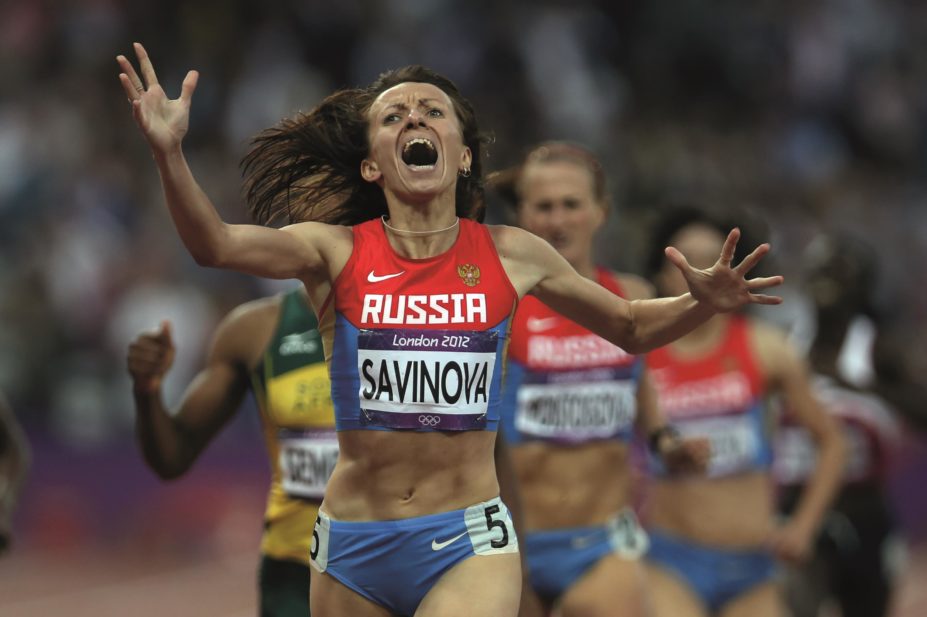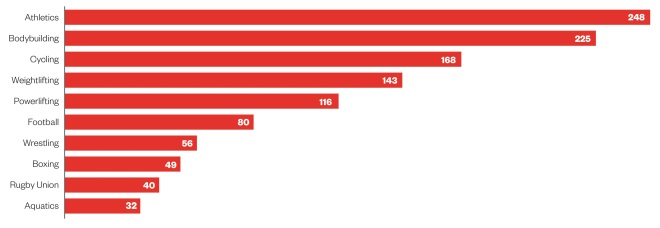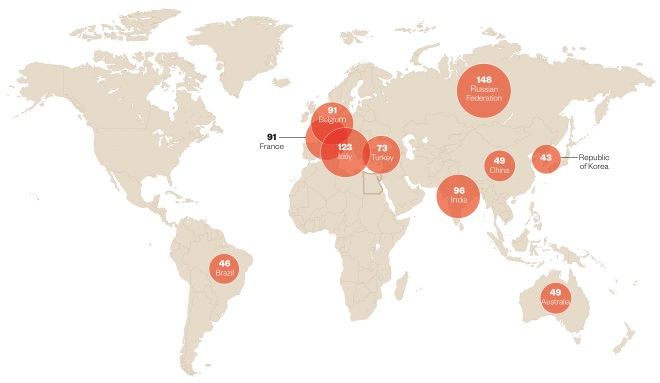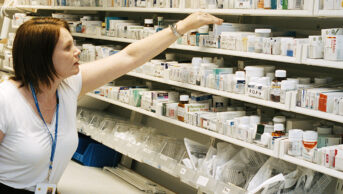
Ian MacNicol / Getty Images
More than 10,000 athletes from 207 nations will compete at the Rio 2016 Olympic Games in August, and around 3.6 billion viewers around the world will be watching. But after Russian athletes were banned from competing in Rio following allegations of state-sponsored use of performance-enhancing drugs, not all eyes will be on the sporting events. Athletes, trainers, sponsors and the public will be expecting further doping scandals and, behind the scenes, scientists will be racing to keep one step ahead of the drug cheats.
Olivier Rabin, science director at the World Anti-Doping Agency (WADA), is one such scientist. “One of our jobs is to protect the health of the athletes,” says Rabin from his office in Montreal, Canada.

Source: World Anti-Doping Agency (WADA)
Olivier Rabin, science director at the World Anti-Doping Agency, says that one of the agency’s jobs is to protect athletes’ health
Performance-enhancing practices are as old as the games themselves — athletes in ancient Greece chewed on lamb testicles before competing and those at the 1904 games took drugs such as cocaine and heroin to give them the edge. But it wasn’t until the amphetamine-induced death of Danish cyclist Knud Jensen in the Rome 1960 Olympics that performance-enhancing substances were banned from the games. “Some people think that intervening to protect athletes’ health is too paternalistic but it’s like any public health measure, like wearing a seat belt: to limit risk to health this is what you have to do.”
Sport is nothing without values and if you cheat you break those values
There’s also a more “philosophical” reason for WADA’s existence, says Rabin. “Why do you have 11 players in football and why do you have 15 in rugby? Why do you have a certain size of basketball and court?” he asks. “Sport is about rules and what makes it interesting is how you compete within those rules. Sport is nothing without values and if you cheat you break those values.”
Speak with any athletes, says Rabin, “including doped ones, and they all say they would prefer a drug-free competition”. They say they only did it because they thought others were doing it or because they were simply not talented enough to otherwise make it to the top. “Lance Armstrong is a typical case — he would probably have been a reasonably good but not an exceptional cyclist without drugs.”
Athletes who cheat are using ever more sophisticated ways to evade detection, but anti-doping scientists are hot on their heels, using new testing equipment and procedures, as well as smarter ways of testing, to catch them out. Athletes could soon get ahead of scientists, though, by using gene therapy to stimulate the body to produce its own performance-enhancing substances.

Anti-doping rule violations in 2014: top ten sports
Source: World Anti-Doping Agency (WADA)
Athletics topped the list of sports with the most athletes or athlete support persons committing a doping offence in 2014
The drugs
Lance Armstrong won the Tour de France seven times in a row between 1999 and 2005 but was stripped of his titles in 2012 after confessing to taking performance-enhancing drugs. He managed to cheat tests by using substances and methods that could not be detected at the time.
Armstrong and his US Postal cycling team used recombinant human erythropoietin (EPO), a drug designed to treat chronic anaemia by mimicking the actions of natural EPO and stimulating the production of red blood cells. Having more red blood cells improves blood’s oxygen-carrying capacity and therefore an athlete’s performance in endurance sports.
The team also boosted their red blood cell counts by injecting their own or another person’s blood before a race. If an athlete injects another person’s blood, analysis of the cells’ antigen pattern can be evidence of doping. If an athlete uses their own blood, it is more difficult to detect, but over the past decade authorities have started looking for indirect signs of this — fewer reticulocytes, or young red blood cells, can indicate that an athlete has doped (the body slows down production of new blood when blood is reinfused); metabolites from the plastic bags the blood is stored in for freezing are also a tell-tale sign.
“Anything that closely mimics endogenous compounds or processes is difficult to detect,” says David Cowan, director of the Drug Control Centre at King’s College London. “Like with any type of drug misuse, these doping athletes will try using whatever they can get hold of.” Human-growth hormone (hGH), insulin, and insulin-like growth factor-I (IGF-I) are all examples of licensed, medicinal products that have been repurposed by athletes.
We have several cases a year of legal highs or new designer steroids that we’re facing that we need to figure out tests for
“Then there are substances made by rogue scientists and illegal laboratories around the world,” adds Rabin. “We have several cases a year of new stimulants [legal highs] or new designer steroids that we’re facing that we need to figure out tests for.”
The most famous example of a so-called designer steroid was ‘The Clear’, or tetrahydrogestrinone, a steroid specifically designed to evade tests. In 2003, after a US sprint coach tipped off the US Anti-Doping Agency, scientists used a syringe of the drug he had sent them to develop a way to detect it. Authorities could then make prosecutions and strip athletes — most notably US track and field athlete Marion Jones — of their fraudulently won titles.
“More recently you have selective androgen receptor modulators (SARMs)”, says Anthony Butch, professor of pathology and director of the University of California, Los Angeles’ Olympic Analytical Laboratory, referring to a class of therapeutic compounds banned by WADA since 2008. They are designed to have the same effects as anabolic steroids but without the unwanted side effects, such as a deeper voice and increased facial and body hair in women, and shrinking of the testicles in men.

Source: Courtesy of Anthony Butch
Anthony Butch, professor of pathology and director of the University of California, Los Angeles’ Olympic Analytical Laboratory, says that small changes to the backbone structure of selective androgen receptor modulators makes them difficult to detect
“Because there are so many different SARMs coming out,” says Butch, “each with small changes to the backbone structure, you have very different compounds and when you’re looking for specific compounds you may miss them. They can be difficult to detect.”
Add to this the fact that athletes often try to mask their drug use — from brazen prosthetic penises for bogus urine tests to more sophisticated use of tamoxifen to counteract increased oestrogen that comes with testosterone doping, or use of human chorionic gonadotropin to boost endogenous testosterone production that wanes with anabolic-steroid use — anti-doping scientists can be left feeling that they’re fighting an endless battle.
Better tests
There are reasons to be optimistic, however. Thanks to new testing equipment and procedures, for instance, a record 5,000 athletes were tested during the 19-day London 2012 Olympics.
“Everything had to be super-fast,” says Cowan, who led the testing. Tests had to be turned around in 24 hours rather than the usual 10 days, a feat that was only achievable thanks to new technology. At the time, gas chromatography–mass spectrometry was the gold standard for forensic identification of substances. “We took it to the next step and used the improved gas chromatography–tandem mass spectrometry: it’s like having two mass spectrometers in the box.” The extra muscle meant that testing each sample took 10 minutes instead of the previous 40 minutes.
They take smaller and smaller doses so that they stay below the detection limit
New technology, explains Butch, means that tests can also fulfil another need: to be extra sensitive. “Doping athletes are now more sophisticated in that they don’t typically take a large dose of something,” he says. “They take smaller and smaller doses so that they stay below the detection limit.” So-called microdosing, as done by Lance Armstrong, along with injecting substances such as EPO directly into veins rather than into muscle, means that drugs can be cleared from the body within days. “They basically had to be taking the syringe out of their thighs for us to catch them because the window for the test is so short.”
Technology, such as gas chromatography–tandem mass spectrometry, gives scientists a better chance: the lower they can detect a compound in someone’s blood the more likely they are to catch people who dope. “If I could detect say five years ago an anabolic agent down to 10.0 nanograms per ml, now we can detect it down to 0·5 nanograms per ml — it’s really expanded that detection window,” says Butch. “We can see things we couldn’t see before.”
Smarter testing
Another way to extend the window is to be smarter about what you look for. For instance, the concentration of hGH in the body naturally fluctuates, making it difficult to detect whether an athlete has artificially inflated it. Thanks to an immunoassay developed and validated by scientists, including Cowan, authorities can now identify different isotopes of the hormone that would suggest use of exogenous, recombinant hGH. The assay extended the detection window for the hormone from 24–36 hours to almost 2 weeks, says Cowan, and its use at London 2012 caught two Russian powerlifters in the Paralympic games.

Anti-doping rule violations in 2014: top ten nationalities
Source: World Anti-Doping Agency (WADA)
Russia topped the list of countries where the most athletes or athlete support persons committed a doping offence in 2014
WADA has been funnelling money into anti-doping science since its inception: US$69m to date, including US$12m in 2015. Rabin says the organisation normally has priority themes: “It can be improvement of detection methods or, like more recently, detection of long-term metabolites, or metabolites of metabolites of banned substances, to stretch the detection window even further.”
Instead of creating a test for every single drug or method, we can look at the things that, say, cause growth hormones to go up in the body
It’s part of a shift in thinking to try to break the cat and mouse chase between dopers and scientists. “Instead of creating a test for every single drug or method,” says Butch, “we can look at the things that, say, cause growth hormones to go up in the body.” For example, hGH stimulates the liver to make IGF-I but it also causes collagen formation, so scientists look at levels of procollagen III N-peptide. “This approach greatly increases the detection window after the use of hGH.”
The Athlete Biological Passport (ABP), a mandatory scheme for Olympic athletes that started in 2009, is another example of this change of tack. Athletes, who have to declare any drugs that they take and make authorities aware of their whereabouts for random testing, give regular blood samples so that authorities can monitor biomarkers of doping (reticulocyte count or total haemoglobin mass, for example) and flag up and investigate any abnormalities.
Improved regulations and diminishing returns
The World Anti-Doping Code, known as ‘the Code’, pulls together international regulations and standards in five areas: testing procedures; laboratory standards; the list of prohibited substances and methods; therapeutic use exemptions (to help determine whether an individual is using a drug for genuine medical reasons); and the protection and privacy of personal data.
The list of prohibited substances and methods was first published by the International Olympics Committee in 1963, three years after Knud Jensen’s death. WADA has since subsumed its maintenance, publishing its first version of the list on 1 January 2004, and publishing an updated version on the same date each subsequent year. Drugs such as steroids or stimulants that are licensed and on the market are easier to prepare for than illegal drugs or drugs still in the developmental pipeline, says Rabin.
To get a better understanding of what types of drugs may be being used in this second category, WADA works closely with police forces, Interpol and the UN Office on Drugs and Crime. It also collaborates with pharmaceutical companies, which share detailed pharmacokinetic and pharmacodynamic data for drugs in clinical development that might have doping potential. It has been a successful partnership.
“A good example is Micera from Roche,” says Rabin. “We started looking at it in 2003, it took several years to validate a good method to test it and we were able to implement that test just about the same time as the drug came on to the market [in 2008].” Micera, the trade name for continuous erythropoietin receptor activator (CERA), was used in the Beijing Olympic Games in 2008 and several athletes were caught. Collaboration with San Francisco-based biotechnology company Fibrogen led to tests being implemented for its anaemia drug roxadustat before the drug reached the market.
Typically, a case can be built and prosecuted with no analytical proof of doping but substantial evidence, testimony and indirect proof that they doped
Implementation of the code and the introduction of the ABP scheme has made it easier to prosecute for so-called non-analytical violations in the absence of a positive drugs test, says Rabin. “Today, if you’ve got solid information to demonstrate doping you can prosecute a case,” he says. For example, testimony from team mates and coaches and sometimes even the entourage of the athlete. “Typically, a case can be built and prosecuted with no analytical proof of doping but substantial evidence, testimony and indirect proof that they doped.”
These advances, say both Cowan and Butch, mean that the landscape is becoming less and less favourable for doping. Especially with the lower detection thresholds and widening detection windows. It’s getting to the point, says Cowan, that athletes have to take smaller and smaller doses less often so the diminishing potential benefits of doping will be outweighed by the severe consequences of getting caught.
They think it’s all over…
It would be foolish for any scientist to rest on their laurels — unlike the rules of sport, the rules of science change constantly. Most recently, improvements in ‘omics’ approaches (genomics, proteomics and metabolomics) are set to add another twist to the tale by first boosting the ability of anti-doping agencies to catch cheats.
Use of RNA fingerprinting and proteomic analysis of blood, if shown to be sensitive and validated, could soon improve scientists’ ability to spot when an athlete’s physiology has been tweaked for a competitive advantage and negate some of the current constraints around testing.
“A big problem we have with tests is the costs and logistics of getting samples to labs,” says Nicolas Leuenberger from the Swiss Laboratory for Doping Analysis in Lausanne. “If you want to measure cells like reticulocytes, which are alive, they need to be transported at 4°C and analysis has to be made within 48 hours,” he explains. “We did the [2014] Rio World Cup samples and getting them to our lab was very difficult and expensive.” ‘Omics’ approaches, he says, allow identification of more stable biomarkers that would reduce the logistical constraints – and costs – of testing, freeing up more money for more tests, which in itself would be a strong deterrent. Samples may even be able to be transported as dried blood spots.
Leuenberger’s own research has focused on the potential of circulating microRNA profiles as an indication of doping[1]
. MicroRNAs are a new biomarker first described as a potential indication of cancer only eight years ago. The mechanics are not well understood, but they are thought to be a marker of increased cellular metabolism. Leuenberger has had success showing the technique’s effectiveness in detecting previous blood transfusion[2]
and testosterone use[3]
. That analyses of microRNAs can be done by polymerase chain reaction, a more widely known and available technique than mass spectrometry, further improves their potential usefulness in clamping down on drug cheats.
You can come up with a great new biomarker but trying to convince people to change their habits and measurements is difficult
As with all ‘omics’ approaches, there’s a long way to go. “You can come up with a great new biomarker but trying to convince people to change their habits and measurements is difficult,” says Leuenberger. “People ask you: what about confounding factors? What if people go training at high altitudes or just train more – how do you know these things won’t cause changes to the microRNA profile?” It’s a nightmare to make all these validation tests but we’re working on it, he adds.
Such stringent validation tests, says Rabin, are necessary: science’s normal 95% confidence intervals don’t stand up in court. “At WADA we work at 99.99%,” he says. “You have to be sure that the drug or phenomenon you reveal is doping. It’s a very high demand on us by the legal system. Needless to say that it has a significant impact on the science we develop.” Sure-footed progress takes time: validation and then implementation of tests for hGH use took five years, says Rabin.
Doping athletes, conversely, are not shackled by regulations and formalities. Our increasing understanding of, and ability to tinker with, human genetics could see the technology that athletes use soon outpace that of scientists. Gene-doping, or use of gene-therapy technology designed to treat genetic disorders, says Butch, is the next battlefield, albeit only a theoretical one for now.
“The concept here would be, I’m a powerlifter and I need my arms and shoulders to be strong so I introduce a gene into the muscle that causes a natural anabolic agent to be produced, or to turn something off that’s usually on,” he says. “EPO is another thing. You can send in a genetic message that will tell your body to make more red blood cells.”
The question is, how do you test for such doping techniques? “It’s going to be difficult,” says Butch, “Maybe we might be able to detect the virus used as a vector to get the gene into a cell?” As with all bootlegged therapies that have not gone through proper testing, the side effects for such genetic tampering are unknown, but that may not be a deterrent. “What we’ve learnt from history is that these athletes are willing to take all kinds of risks,” he says. “[Use of gene therapies to dope] is probably not happening right now but I suspect that we’re a little closer to it than we think.”
References
[1] Leuenberger N & Saugy M. Circulating microRNAs: the future of biomarkers in anti-doping field. Adv Exp Med Biol 2015;888:401–408. doi: 10.1007/978-3-319-22671-2_20
[2] Leuenberger N, Schumacher YO, Pradervand S et al. Circulating microRNAs as biomarkers for detection of autologous blood transfusion. PLoS One 2013;8(6): e66309. doi: 10.1371/journal.pone.0066309
[3] Salamin O, Jaggi L, Baume N et al. Circulating microRNA-122 as potential biomarker for detection of testosterone abuse. PLoS One 2016;11:e0155248. doi: 10.1371/journal.pone.0155248
You may also be interested in

More than 40% of people with ADHD waiting at least two years to access mental health service, study finds

Preparing for the GPhC registration exam: six steps to help you effectively plan your revision
